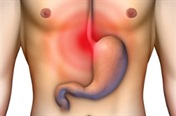
Alternative names: Pyrosis, acid indigestion
Heartburn can be described as a feeling of discomfort, burning or pain behind the breastbone, near the heart (hence the term “heartburn”, even though the heart isn’t involved).
This uncomfortable feeling appears to rise from the stomach up towards or into the throat, and typically occurs after eating a meal. Heartburn is often accompanied by reflux, the regurgitation of stomach acid (also called “gastric juice”) into the oesophagus (the body’s feeding pipe). The acid can burn the delicate lining of the oesophagus and leave a bitter or sour taste in the mouth.
Heartburn can be a sign of an underlying problem or disease. This nagging symptom becomes pathological when it starts to impair your quality of life or if complications occur.
Chronic heartburn is usually the result of gastro-oesophageal reflux disease (GORD), a condition in which the volume of stomach contents that refluxes into the oesophagus exceeds the normal, healthy limit. This condition requires long-term treatment and can lead to serious complications.
The processes involved
Heartburn may occur normally, when some stomach acid moves up into the oesophagus as a result of what you’ve had to eat or drink, or it may be a symptom of a more serious problem.
In healthy people, reflux of the stomach’s contents into the oesophagus is kept to a minimum, thanks to the body’s so-called anti-reflux barrier. This is made up of two sphincters: the lower oesophageal sphincter (LOS) and the crural diaphragm (also called the “diaphragmatic sphincter”). Both sphincters are made up of strong muscles that allow these valve-like structures to open and close, letting food move down from the oesophagus into the stomach, and beyond.
Sometimes, however, it just so happens that these sphincters don’t close tightly enough after food has passed through it. When this happens, stomach acid (essential for digesting food and killing bacteria) flows back up into the oesophagus. This is called reflux.
The tendency to experience reflux increases when the stomach contains a lot of acid and food. Normal, non-pathological reflux typically occurs after eating a meal (especially a large meal), an episode is usually brief, and it isn’t associated with severe pain or discomfort.
However, in a great percentage of people heartburn occurs more frequently than it should. In many, it’s also associated with larger volumes of acid reflux. When this happens, the acid can start to damage the lining of the oesophagus, leading to more severe symptoms. In many instances, the diagnosis is gastro-oesophageal reflux disease (GORD), one of the most common conditions associated with heartburn.
GORD may be the result of one or more of the following:
- Transient lower oesophageal sphincter (LOS) relaxations, where the band of muscle around the bottom of the oesophagus relaxes more often than it should or at the wrong time. This is the primary cause of GORD.
- Hiatal hernia, where a part of the stomach protrudes through a small opening (hiatus) in the diaphragm – the thin, dome-shaped muscle that separates the thoracic and abdominal cavities. This can allow stomach contents to flow back up into the oesophagus. Note, however, that not all people with hiatal hernias experience heartburn.
- Impaired oesophageal clearance, where acid that has flowed into the oesophagus from the stomach isn’t cleared quickly enough.
- Delayed gastric emptying (also called “gastroparesis”), where food remains in the stomach for an abnormally long time. Most often, this is the result of (AUTONOMIC) nerve damage.
- Impaired mucosal defensive factors, where the salivary and mucus-secreting glands in the digestive system don’t work as they should – a type of degeneration that often occurs with increasing age.
Interestingly, Africans and Asians appear to be at lower risk for the complications associated with GORD, including Barrett's oesophagus (see ‘Possible complications’). It’s thought that the pathophysiology of GORD (i.e. the functional changes in the digestive system associated with the condition) may differ among populations. More research needs to confirm whether this really is the case.
Reviewed by Dr Estelle Wilken, senior specialist in Internal Medicine and Gastroenterology at Tygerberg Hospital. March 2017.




 Publications
Publications
 Partners
Partners
















